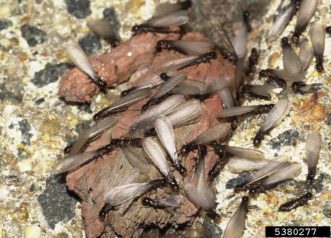Termite Swarmers
go.ncsu.edu/readext?854742
en Español / em Português
El inglés es el idioma de control de esta página. En la medida en que haya algún conflicto entre la traducción al inglés y la traducción, el inglés prevalece.
Al hacer clic en el enlace de traducción se activa un servicio de traducción gratuito para convertir la página al español. Al igual que con cualquier traducción por Internet, la conversión no es sensible al contexto y puede que no traduzca el texto en su significado original. NC State Extension no garantiza la exactitud del texto traducido. Por favor, tenga en cuenta que algunas aplicaciones y/o servicios pueden no funcionar como se espera cuando se traducen.
Português
Inglês é o idioma de controle desta página. Na medida que haja algum conflito entre o texto original em Inglês e a tradução, o Inglês prevalece.
Ao clicar no link de tradução, um serviço gratuito de tradução será ativado para converter a página para o Português. Como em qualquer tradução pela internet, a conversão não é sensivel ao contexto e pode não ocorrer a tradução para o significado orginal. O serviço de Extensão da Carolina do Norte (NC State Extension) não garante a exatidão do texto traduzido. Por favor, observe que algumas funções ou serviços podem não funcionar como esperado após a tradução.
English
English is the controlling language of this page. To the extent there is any conflict between the English text and the translation, English controls.
Clicking on the translation link activates a free translation service to convert the page to Spanish. As with any Internet translation, the conversion is not context-sensitive and may not translate the text to its original meaning. NC State Extension does not guarantee the accuracy of the translated text. Please note that some applications and/or services may not function as expected when translated.
Collapse ▲This article was written by Gail Griffin, Extension Master Gardener Volunteer with North Carolina Cooperative Extension in Lee County.
When cold weather begins to wane, we look forward to warming sunshine, leaves returning and buds swelling with renewed life. All around us wildlife is teeming, birds are seeking out their nests, bees are buzzing, butterflies fluttering, and termites are swarming. Wait. What? Yes, unfortunately this is the time of year we are reminded that termites are a part of our southern ecosystem. Late winter, when temperatures rise and especially after rainfall, mature winged adults swarm from their original nesting site in search of forming new colonies. This activity continues until September or October. Outdoors, this is a natural occurrence but if this is happening indoors, you definitely have issues.
The Eastern subterranean termite is a native species of North Carolina and one of our most common types. They live below ground and feed on woody materials like tree stumps. A single colony can forage over a 1/3 acre site. Swarming is an indication that termites are nearby. Several species of winged ants that resemble termites also swarm at this time, so correct identification is needed. Termites are not present on the soil surface, but instead travel through it. Their tunnels result in mud tubes made of soil, particles of wood and other materials. These tubes can be  found on foundation walls, floor joists and other parts of structures. If tubes are opened, live termites can be observed. If they are empty, it doesn’t mean they have left the area. In fact, they can rebuild damaged tubes which is another indication that they are currently active. Termites can feed on any products containing cellulose including paper, cardboard, wood paneling, sheetrock and carpeting. They will also tunnel through plastic or foam board in order to reach a food source. If tubes are present in ceilings or in upper levels, it means there is an above ground infestation and they actually live in the building. This may suggest that there is a serious moisture problem or a leak in the structure. Areas of soft wood that are easily penetrated by a knife or screwdriver or wood that has a hollow sound when tapped may pinpoint where damage has occurred. There can be a thin, gritty grayish film on the surface of damaged material.
found on foundation walls, floor joists and other parts of structures. If tubes are opened, live termites can be observed. If they are empty, it doesn’t mean they have left the area. In fact, they can rebuild damaged tubes which is another indication that they are currently active. Termites can feed on any products containing cellulose including paper, cardboard, wood paneling, sheetrock and carpeting. They will also tunnel through plastic or foam board in order to reach a food source. If tubes are present in ceilings or in upper levels, it means there is an above ground infestation and they actually live in the building. This may suggest that there is a serious moisture problem or a leak in the structure. Areas of soft wood that are easily penetrated by a knife or screwdriver or wood that has a hollow sound when tapped may pinpoint where damage has occurred. There can be a thin, gritty grayish film on the surface of damaged material.
For preventative measures, find and eliminate any moisture problems that are present. Avoid storing debris containing wood or paper in spaces near ground level. Check around the foundation and crawl space for mud tubes. Spraying swarmers or surfaces of damaged wood will not stop the infestation or protect from future damage. The most commonly used method is a trench and treat application of termiticides around the entire foundation, interior crawl space, walls and piers. An inspection from a reputable pest management company can help determine if there is current activity. If entering into a pest control agreement, read the entire contract and learn all possible aspects and guarantees including expectations of retreatment and use of baiting systems. A list of regulations can be found under the NC Department of Agriculture and Consumer Services- Structural Pest Control and Pesticides Division.
Helpful information can be found at content.ces.ncsu.edu/tips-on-selecting-pest-control-services.
A DIY (do it yourself) approach is usually not recommended. Proper treatment is complex. Applications of termiticides in confined spaces require respirators and clothing used in handling hazardous materials. Rates could exceed one hundred gallons of chemicals depending on the depth of footings and the size of structure(s) being treated. Concrete slabs will need to be drilled in order to apply the chemicals necessary to treat the area. The Environmental Protection Agency requires manufacturers of these chemicals to prove their product is effective for five years, but if the soil is disturbed, the treatment may not linger. For more on termites, go to content.ces.ncsu.edu/termites-biology-and-control.
Swarming termites can be a nuisance, but are a part of the natural scheme of things in the great outdoors. There is no need to panic, just be aware that we need to stay vigilant in maintaining and protecting the investment we call home.
Gail Griffin is an Extension Master Gardener Volunteer with North Carolina Cooperative Extension in Lee County.




